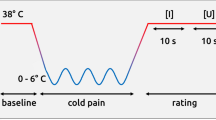Abstract
Treatments expected to raise the level of arousal and induce different degrees of positive and negative affect were paired on some trials with Renaissance or 20th-century paintings, whereas no paintings were shown on other trials. The design was within-subjects (24 females); the dependent measures were skin conductance (SC) and the preference for paintings. All treatments, including the paintings/no paintings factor, raised SC over the base-line, and the pattern was essentially additive. The perceived failure to attain control over aversive auditory stimulation (resulting in negative affect) raised SC to a higher level than did the unavoidable aversive stimulation (minimal affect) or monetary gains (positive affect). Paintings paired with affect (positiveor negative) were rated as more pleasing than were those paired with no affect. The Renaissance works were preferred to the 20th-century works when negative affect was induced, whereas the opposite was true in the case of positive affect. The collative-motivation model could not account for the fact that pleasingness of paintings was not related to SC by an inverted-U function. The contiguity model could not explain the considerable rated pleasingness of paintings paired with negative affect. In contrast, there was considerable support for a more comprehensive hypothesis (“distraction/soothingness”) based on attentional and affective considerations, and the differential cognitive labeling of fluctuations of arousal.
Similar content being viewed by others
References
Berlyne, D. E.Conflict, arousal and curiosity. New York: McGraw-Hill, 1960.
Berlyne, D. E. Arousal and reinforcement. In D. Levine (Ed.),Nebraska symposium on motivation (Vol. 15). Lincoln: University of Nebraska Press, 1967.
Berlyne, D. E.Aesthetics and psychobiology. New York: Appleton-Century-Crofts, 1971.
Berlyne, D. E., (Ed.).Studies in the new experimental aesthetics. New York: Hemisphere Publishing, Wiley, 1974.
Berlyne, D. E., Craw, M. A., Salapatek, P. H., & Lewis, J. L. Novelty, complexity, incongruity, extrinsic motivation, and the GSR.Journal of Experimental Psychology 1963,66 560–567.
Brady, J. V., Porter, R. W., Conrad, D. G., & Mason, J. W. Avoidance behavior and the development of gastroduodenal ulcers.Journal of Experimental Analysis of Behavior 1958,1 69–73.
Bryson, J. B., & Driver, M. J. Conceptual complexity and internal arousal.Psychonomic Science 1969,17 71–72.
Edwards, A. E., & Treadwell, T. Cardiovascular response to experimentally induced repressed anger.Proceedings of the 75th Annual Convention of the American Psychological Association, 1967, 183–184.
Kahn, M. The physiology of catharsis.Journal of Personality and Social Psychology 1966,3 278–286.
Konečni, V. J. Annoyance, type and duration of post-annoyance activity, and aggression: The “cathartic effect.”Journal of Experimental Psychology: General 1975,104 76–102. (a)
Konečni, V. J. The mediation of aggressive behavior: Arousal level vs. anger and cognitive labeling.Journal of Personality and Social Psychology 1975,32 706–712. (b)
Konečni, V. J., Crozier, J. B., & Doob, A. N. Anger and expression of aggression: Effects on aesthetic preference.Scientific Aesthetics 1976,1 47–55.
Konečni, V. J., & Doob, A. N. Catharsis through displacement of aggression.Journal of Personality and Social Psychology 1972,23 379–387.
Konečni, V. J., & Sargent-Pollock, D. Choice between melodies differing in complexity under divided-attention conditions.Journal of Experimental Psychology: Human Perception and Performance 1976,2 347–356.
Konečni, V. J. Quelques déterminants sociaux, émotionnels et cognitifs des préférences esthétiques relatives à des mélodies de complexité variable.Proceedings of the 6th International Colloquium of Experimental Aesthetics (Paris, 1976), in press. (Available in English as a technical report entitled “Some social, emotional, and cognitive determinants of aesthetic preference for melodies differing in complexity.”)
Schachter, S. The interaction of cognitive and physiological determinants of emotional state. In L. Berkowitz (Ed.),Advances in experimental social psychology (Vol. 1). New York: Academic Press, 1964.
Zillmann, D., Katcher, A. H., & Milavsky, B. Excitation transfer from physical exercise to subsequent aggressive behavior.Journal of Experimental Social Psychology 1972,8 247–259.
Author information
Authors and Affiliations
Additional information
This research was supported by Grant GS-42802 from the National Science Foundation to VJK. Some of the findings were presented at the 6th International Colloquium of Empirical Aesthetics, and the 21st International Congress of Psychology, both held during July 1976 in Paris, France.
Rights and permissions
About this article
Cite this article
Konečni, V.J., Sargent-Pollock, D. Arousal, positive and negative affect, and preference for Renaissance and 20th-century paintings. Motiv Emot 1, 75–93 (1977). https://doi.org/10.1007/BF00997582
Issue Date:
DOI: https://doi.org/10.1007/BF00997582




